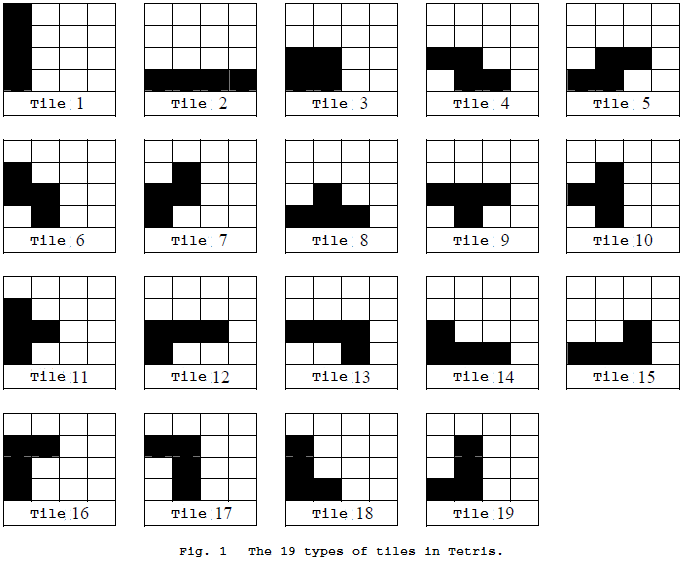NOI '02 P5 - New Tetris
View as PDFNational Olympiad in Informatics, China, 2002
Yuan Yuan is getting tired of the traditional game of Tetris, so she
has decided to create a new set of rules. The game takes place on an
infinitely-tall grid of
columns, where the
columns of the grid from left to right are labeled from
to
. In
this game, the player uses the
types of tiles depicted in figure 1.
Every such tile is made up of exactly four smaller squares. The picture
contains the numberings of the tiles
.

The rules of the game are as follows:
- To describe the status of the grid: Every possible state of the grid
in the game is described using the number of consecutive squares in
each column. For example in figure 2, the grid contains
columns. Column
contains
small squares. Column
contains two small squares. Column
contains
small squares. Column
contains
small squares. Therefore, we can use the
-tuple
to describe this grid state.
- The game initially selects a tile
and drops it into a specified column
. The command is described by the pair
. That is, the leftmost square(s) of tile number
is lined up with column
and dropped. An example is depicted in figure 2, where tile number
is placed in column
, representing the command
. The tile continues to fall until it reaches the bottom of the grid, immediately creating the game state
. However since the bottom two rows are filled completely, the rules will make these two rows automatically vanish, reaching the state depicted in figure 3, denoted by
.
- The game ends when the number of squares in all the columns is
. For example, when tile number
is selected and dropped in the leftmost column of the grid in figure 3 using the command
, the immediate game state would become
. The two entire rows vanish after being filled, resulting in the game state
, finally successfully ending the game.
- The rules require that tiles never occupy regions outside of the
bounds of the grid. For example, in figure 2 where
, the command
will be out of bounds.
- The rules require that no tiles may produce "floating" squares. A
floating square is a square positioned such that not all of the
squares in its column are consecutive. Figure 5 is one such
situation. For example, in the grid for figure 2, the commands
,
, and
are all illegal.

Although the ability to pick which tiles drop greatly simplifies the game, completely getting rid of all the squares still remains a very annoying task. Would you like to try?
Input Specification
The first line of input contains an integer , the number of columns.
The second line contains
integers, representing the initial
state of the grid. Each integer on this line represents the number of
consecutive squares in the corresponding column.
Output Specification
The output should contain many lines of commands. Each line should
contain two integers and
, separated by a space. It is guaranteed
that there is a solution, although not necessarily unique. You may
output any such solution.
Sample Input
4
3 2 3 0Sample Output
1 4
9 1Scoring
For each test case, your score out of will be:
, if your output is incorrect or the number of commands exceeds
.
, if your output is correct but the number of commands exceeds
.
, if your output is correct and the number of commands does not exceed
.
Problem translated to English by .
Comments